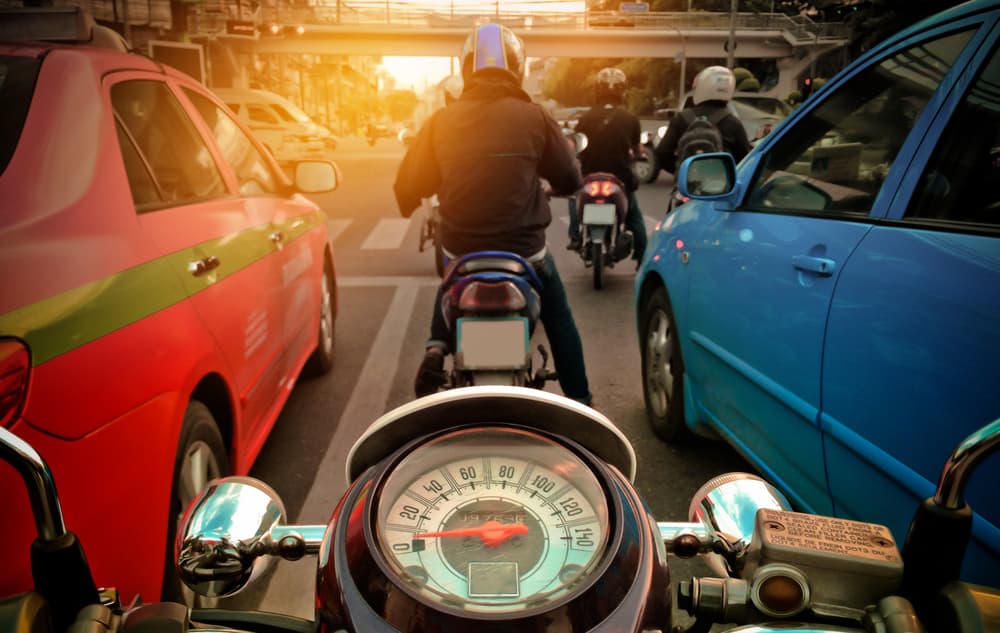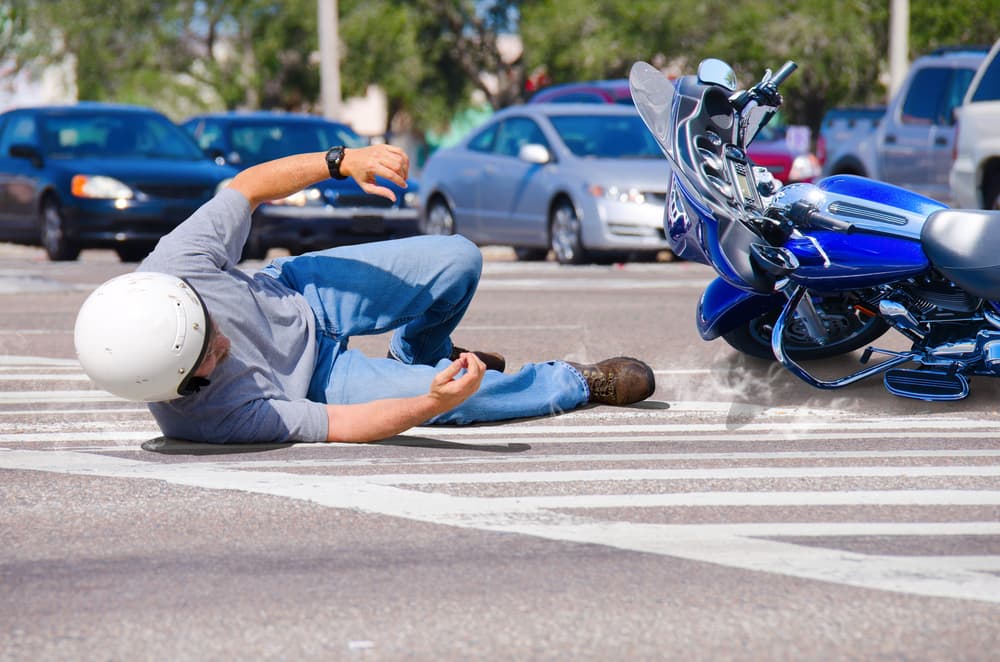Understanding who has the right of way in a given situation keeps drivers and motorcycle riders safe.
But what determines the right of way? Do motorcycles always have to yield the right of way to cars? And what are the consequences for not obeying right of way laws?
These questions become especially pressing after an accident.
Here’s the bottom line: Motorcycle riders do not always have to yield to cars. You can demand compensation if a driver injures you after ignoring right of way laws.
This guide explains what right of way means, how to know whether you have the right of way, and how a knowledgeable motorcycle accident attorney can help you recover compensation if someone injures you after failing to yield the right of way to you.
What Does Right of Way Mean?
When you ride your motorcycle, knowing who gets to go first at intersections or anywhere drivers’ paths cross is what the right of way is all about.
For example, imagine that you are approaching a four-way stop sign. The right of way laws tell everyone who should move through the intersection first. These rules help keep traffic moving smoothly and prevent crashes.
Cars and Motorcycles Must Share the Right of Way
One fundamental principle of right of way laws is that everyone must follow the same rules. In other words, all vehicles are equal in the eyes of the law.
For example, a driver in a car does not automatically take priority at an intersection over someone riding a motorcycle. Instead, who goes first depends on who arrived first at the intersection, their relative position at the intersection, and other factors.

General Right of Way Laws To Know
While individual states have pages and pages of right of way laws drivers must follow, they generally follow the same basic principles.
For example, here are the essential right of way laws drivers in Georgia must obey:
- When two vehicles approach an intersection without a traffic light, and both drivers have a stop or yield sign, the driver who arrived first has the right of way.
- When two vehicles approach an intersection without a traffic light at the same time, and both drivers have a stop or yield sign, the driver on the left must yield the right of way to the driver on the right, allowing them to proceed first through the intersection.
- When a vehicle approaches an intersection from a road that terminates at the intersection, the driver must yield the right of way to any traffic near or already passing through the intersection.
- If a traffic light malfunctions, any driver approaching the intersection must treat it as an all-way stop. The driver who arrives first at the intersection has the right of way. Should two or more drivers arrive at the same time, drivers on the left must yield to other drivers on their right.
- When making an unprotected left turn, drivers must yield the right of way to any traffic already in the intersection or close enough to the intersection to pose a safety hazard. However, drivers approaching an intersection should watch for and yield the right of way to other vehicles turning in front of them.
- Drivers can turn right on a red light after coming to a complete stop at the intersection and yielding the right of way to any traffic already in the intersection (along with any pedestrians crossing the intersection).
- Drivers may only turn left at a red light if they are on a one-way street, they have come to a full stop, they are turning onto a one-way street, and there are no other vehicles in the intersection.
- Drivers entering a roadway from an alley, private drive, or any place other than a roadway must yield to existing traffic.
- When merging into traffic (for example, on highway on-ramps), drivers must yield the right of way to any vehicles already in the lane they wish to join.
Common Types of Right of Way Accidents
Even with clear rules, right of way accidents can happen.
Some typical accidents that come from right of way mistakes include:
- Intersection Collisions: Intersections are hot spots for accidents. Cars might collide with each other when drivers misjudge who gets to go first. This can lead to a quick and dangerous smash-up.
- Turning Troubles: When drivers make turns at intersections, especially left turns, they can crash into oncoming cars. This happens when drivers are in a hurry or not paying attention to other vehicles coming their way. Alternatively, a careless driver might crash into another vehicle turning left in front of them if they do not watch the road.
- Yellow Light Dashes: Sometimes, drivers see a yellow light and step on the gas instead of slowing down. They zip into the intersection just as other cars start to drive forward with the green light, leading to crashes.
- Merging Mishaps: When cars merge onto or off the highway without looking out for other vehicles that are already there, they can slam into each other, causing chaos at high speeds.
By understanding right of way laws, drivers and motorcyclists can stay more alert and avoid severe injuries.
Common Injuries From Right of Way Accidents
When a right of way crash occurs, the consequences can range from minor to severe. Here are some common injuries motorcycle riders might face:
Whiplash
This neck injury happens from the sudden back-and-forth movement of the head that frequently occurs in rear-end collisions.
Broken Bones
Arms, legs, ribs, and even hips can break when a rider’s body slams against parts of the motorcycle, the road, another vehicle, or gets crushed in the impact.
Concussions
A concussion is a brain injury that can happen after a hard blow to the head, leaving victims dazed, confused, or even unconscious. Concussions can also result in long-term brain damage in severe cases.
Road Rash
Riders thrown from their motorcycles can slide across the pavement, resulting in painful abrasions commonly called road rash.
Internal Injuries
The force of a collision can cause serious internal bleeding or damage to organs, though they might not immediately manifest.
Spinal Cord Injuries
These injuries can occur from a severe impact, potentially leading to paralysis or long-term disabilities.
How to Protect Your Rights After a Failure To Yield Accident
As you recover from a failure-to-yield accident, you must take appropriate steps to protect your right to compensation.

Here’s what to do to set yourself up for a successful claim:
- Follow up on Medical Care: Keep all your doctor’s appointments and follow your healthcare providers’ advice to the letter. This shows your commitment to getting better and helps document your injuries.
- Document Everything: As soon as possible, start writing down how your injuries affect your day-to-day life. Missed workdays, struggles during recovery, and any pain or discomfort should all go in your diary.
- Stay Organized: Keep a file of all your accident-related documents. This includes the police report, all medical records, correspondence with insurance companies, and any receipts for expenses related to the crash.
- Communicate Carefully: Insurance companies might try to get you to settle for less than you deserve. Talk to a lawyer before agreeing to anything or giving a recorded statement.
- Check Your Bike: Don’t rush to fix your bike. It constitutes important evidence of the crash. Get a professional estimate of the damage and take photos if you didn’t do so right after the accident.
- Monitor Your Finances: Keep track of lost income if the accident kept you from working. This includes not just your salary but any missed opportunities, bonuses, or benefits.
- Expand Your Evidence: Look for more evidence to support your claim. This might include traffic camera footage or safety reports about the accident location.
- Contact Witnesses: If anyone else saw the accident, reach out to them to get their accounts of what happened.
- Stay Off Social Media: Don’t share details about the accident or your recovery online. Insurance companies can twist your words or even use a simple picture from a post to argue that your injuries are not as severe as you say.
- Hire an Experienced Motorcycle Accident Attorney: The sooner you speak to a lawyer after a collision, the more they can do to help you. A motorcycle accident attorney can handle negotiations with the insurance company, gather evidence to substantiate your case, and prepare a solid case if your claim goes to court.
Taking these steps can help you build a strong foundation for your compensation claim after a motorcycle accident. Remember, the road to recovery includes taking care of both your health and your legal rights.
Who’s Liable for a Right of Way Crash?
Because all drivers and motorcycle riders must obey right of way laws at all times, whoever breaks the law usually bears responsibility for a crash. However, it is not always clear who broke the law in a collision, or the parties involved in the crash might dispute what happened.
In these cases, an analysis of the available evidence can reveal who will pay compensation for the other party’s injuries. An experienced personal injury lawyer can gather evidence to support your claim while you focus on healing from your injuries.
How to Prove Fault in a Motorcycle Right of Way Accident Case
Clear, convincing evidence is the bedrock of any successful motorcycle accident claim. Moreover, your evidence must outweigh whatever proof the other party has in their favor.
Some of the most common evidence used in these cases are:
- Police Report: A report from law enforcement provides an official account of the accident. Most crash reports include any traffic violations the officer issued and essential details from the scene.
- Photos and Videos: Images capturing the accident scene, vehicle positions, traffic signs, and any damage help paint a clear picture of the events leading up to the crash.
- Witness Statements: People who saw the accident can offer independent accounts that may support your version of the events.
- Medical Records: Documentation of your injuries from healthcare providers can help prove the extent and severity of your injuries from the crash.
- Traffic Camera Footage: If available, footage from nearby security or traffic cameras can show what happened in real-time.
- Accident Reconstruction Reports: Specialists can recreate the accident using evidence to show how the incident likely unfolded.
- Your Testimony: Your account of the accident is a powerful piece of evidence, provided you have other proof to support your story.
FAQs About Motorcycle Right of Way Accidents
We put together a list of the most common questions we receive about right of way accidents involving motorcycles:
How Much Is a Motorcycle Accident Claim Worth?
While your specific compensation depends on your injuries and other factors, a motorcycle accident claim can help you recover money for many of the losses related to the collision.
With support from an experienced legal team, you could recover compensation for:
- Lost earnings and reduced future income due to an injury or disability
- Past and future medical expenses
- Pain and suffering
- Emotional distress
- Diminished quality of life
- The cost to repair or replace any damaged personal property
How Long Do I Have to File a Motorcycle Accident Lawsuit?
Every state has a law (called a statute of limitations) limiting your time to file a lawsuit after an accident. In Georgia, for instance, you have two years from the accident date to file a lawsuit against the at-fault party. Missing this deadline means you will most likely lose your chance to recover any compensation for your injuries, so speak to an attorney immediately.
How Much Does a Motorcycle Accident Lawyer Cost?

Most motorcycle accident attorneys do not charge any upfront fees. Instead, they only get paid if they obtain compensation for you. This approach allows attorneys to provide representation to anyone who needs it, regardless of their finances. It also gives the attorney an incentive to focus on your case.
